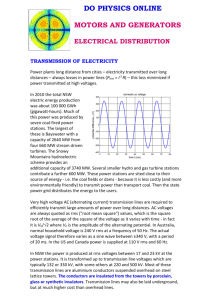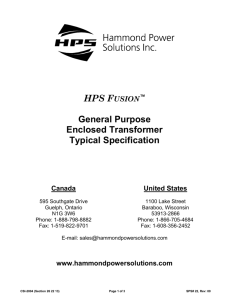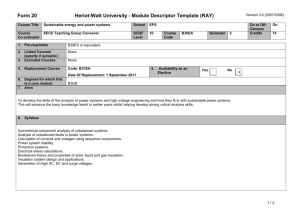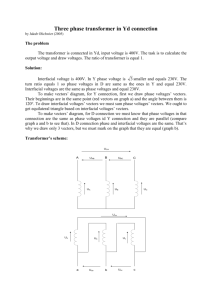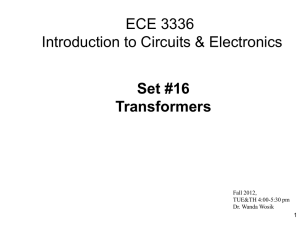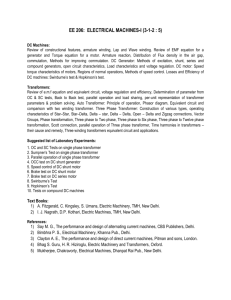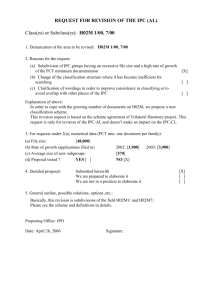to notes18
advertisement
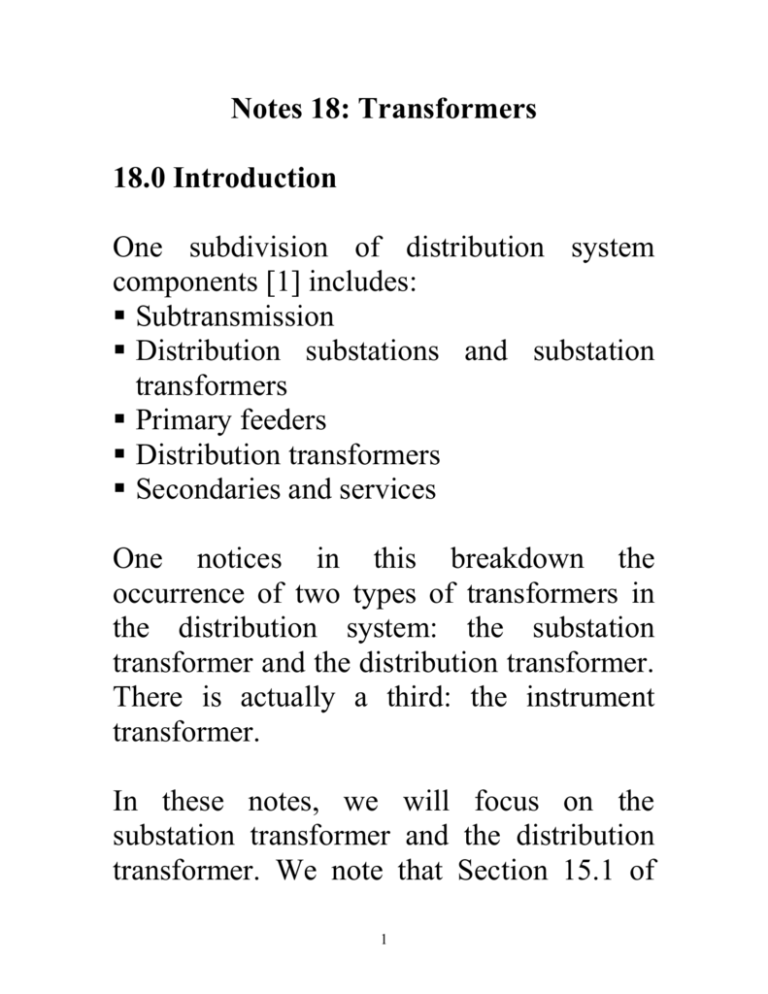
Notes 18: Transformers 18.0 Introduction One subdivision of distribution system components [1] includes: Subtransmission Distribution substations and substation transformers Primary feeders Distribution transformers Secondaries and services One notices in this breakdown the occurrence of two types of transformers in the distribution system: the substation transformer and the distribution transformer. There is actually a third: the instrument transformer. In these notes, we will focus on the substation transformer and the distribution transformer. We note that Section 15.1 of 1 “Notes 15” treats the two-winding transformer theory, and so we will not review those basics here. 18.1 Intro to substation transformers [2] The substation transformer falls under the heading of a power transformer. (Power transformers also include those used in the transmission system.) Their ratings generally fall within the range of 500 kVA (5 MVA) in smaller rural substations to over 8000 kVA (80 MVA) at urban substations. Substation transformers are always threephase installations. They are always in the step-down configuration such that the highside connects to the source and the low side connects to the load. 2 The main limitation of power transformers power carrying capability is heating. The most significant effect is deterioration of the paper insulation between the windings. As a result, power transformers have multiple ratings, depending on the cooling method employed. A base rating is the self-cooled rating, where cooling is due only to the natural heat dissipation to the surrounding air. This base rating is referred to as the OA (open-air) rating of the transformer. There are two other ratings traditionally given for substations transformers. The FA (forced-air) rating is the power carrying capability when forced air cooling (fans) are used. The FOA (forced-oil-air) rating is the power carrying capability when forced air cooling (fans) are used in addition to oil circulating pumps. 3 So a typical power transformer rating would be OA/FA/FOA. Each cooling method typically provides an addiiton1/3 capability. For example, a common substation transformer is 21/28/35 MVA. The transformer rating system was revised in 2000. This system has a four letter code that indicates the cooling method(s) as follows: First letter: Internal cooling medium in contact with windings: o O, mineral oil or synthetic insulating liquid with fire point=300ºC. o K, insulating liquid with fire point>300ºC. o L, insulating liquid with no measurable fire point. (See document in C:\jdm\class\455\coursenotes\92005_Transf_Options_Fire_Sens_Loc_Ju for examples of liguids having no measurable fire points, or, on the web, click here. ) Second letter: Circulation mechanism for internal cooling medium: 4 o N, Natural convection flow through cooling equipment and in winding o F, Forced circulation through cooling equipment (i.e., coolant pumps); natural convection flow in windings (also called nondirected flow) o D, forced circulation through cooling equipment, directed from the cooling equipment into at last the main windings. Third letter: External cooing medium: o A, air o W, water Fourth letter: Circulation mechanism for external cooling medium: o N, natural convection o F, forced circulation: fans (air cooling), pumps (water cooling) Therefore we see that OA/FA/FOA is equivalent in the new system to ONAN/ONAF/OFAF. Table 1 shows equivalent cooling classes in the old and the new naming schemes. 5 Table 1 [2] 18.2 Three phase connections As indicated, substations always deliver three-phase power through the power transformer. There are two basic transformer designs: 1.Three interconnected single phase transformers: The main disadvantage is its cost (lots of iron); advantages are: o they are smaller and lighter and therefore easier to transport. o they are relatively inexpensive to repair 6 2.One three-phase transformer: The main advantage is its cost (less iron). Disadvantages are: o Large and heavy; sometimes not transportable. o Expensive to repair. We will focus on the first case, as it is easier to visualize, but all principles all to the second case as well. Interconnection of three single phase transformers may be done in any of 4 ways: Y-Y Δ-Δ Δ-Y Y-Δ These four ways are illustrated in Fig. 1 below. 7 Fig. 1 We can also use simpler diagrams, shown in Fig. 2, where any two coils on opposite sides of the bank, linked by the same flux, are drawn in parallel. 8 Fig. 2 18.3 Turns ratio of 3-phase transformers The turns ratio of 3-phase transformers is always specified in terms of the ratio of the line-to-line voltages. This may or may not be the same as the turns ratio of the actual windings for one of the single phase transformers comprising the 3-phase connection. Nomenclature: Upper case for primary and low case for secondary. 9 Example 1: Consider three single phase transformers each of which have turns ratio of 138kV/7.2kV=19.17. Find the ratio of the line-to-line voltages if they are connected as: a. Y-Y b.Δ-Δ c. Δ-Y d.Y-Δ (Assume all voltages are balanced.) Since we are only interested in the ratio, we may assume any voltage we like is impressed across the primary winding. So we will assume that the primary winding always has 138kV across it, and so the secondary winding always has 7.2 kV impressed across it. We also assume the voltage across the 138kV winding is reference (angle=0 degrees). Recall: line voltages lead phase voltages by 30 degrees. 10 a. Y-Y: V A, LN 138 0 Va , LN 7.2 0 V A, LL 138 30 Va , LL 7.2 30 So the ratio of line-to-line voltages is: 3 (138) 30 3 (7.2) 30 19.17 b. Δ-Δ: V A, LL 1380 Va , LL 7.20 So the ratio of line-to-line voltages is: 138 0 19.17 7.2 0 11 c. Y-Δ: V A, LN 1380 Va , LL 7.20 V A, LL 3( 138 30 ) So the ratio of line-to-line voltages is: 3 (138) 30 3 (19.17) 30 7.20 d. Δ-Y: V A, LL 1380 Va , LN 7.20 Va , LL 3( 7.2 30 ) So the ratio of line-to-line voltages is: 1380 19.17 30 3 (7.2 30 ) 3 12 Conclusion (for balanced voltages): a. Line-to-line ratio for Y-Y and Δ-Δ connection is same as winding ratio. b. Line-to-line ratio for Y-Δ connection is 330 times the winding ratio. c. Line-to-line ratio for Δ-Y connection is 1 30 times the winding ratio. 3 In the above, “Winding ratio” is the 138:7.2, i.e., it is primary side to secondary side of the single phase transformer. We could also show that the ratio of balanced line currents on the primary to the line currents on the secondary are exactly as above. It is possible to connect the transformers appropriately so that voltages and currents on the H.V. side always lead corresponding on the L.V. side. In fact, it is convention in the industry to do so. In the above, (b) satisfies this convention; (c) does not. 13 As evidence of the last paragraph, Fig. 3 shows a Y-Δ transformer wrongly connected, because high-side quantities lag low-side quantities by 30º. Fig. 4 shows how to correct the problem by just changing the connections. Note that these are step-up transformers. 14 Fig. 3 15 Fig. 4 16 The convention to label (and connect) Y-Δ and Δ-Y transformers so that the high-side quantities LEAD low side quantities by 30º is referred to as the “American Standard Thirty-Degree” connection convention. We can show that under this convention, high-side currents also lead low side currents by 30º. 18.5 The Delta-Y Connection The Δ-Y connection (with Y grounded) is a popular connection that is typically used in a distribution substation serving a four-wire Y-feeder system. It is also a useful connection if we want to serve three single phase loads out of the substation. Fig. 5 illustrates the Δ-Y connection. 17 H1-A n t H3-C H2-B + VCA _ + VAB _ + VBC _ + Vt a _ + Vt b _ + Vt c _ Ztb Zta Ia Ztc Ib + Vab + _ Ic + Vbc X2-b _ g X3-c _ Vag X1-a Fig. 5 We observe that the transformer series impedance is modeled on the low voltage (secondary) side. Define nt as the turns ratio of the singlephase transformers from high side to low side, i.e., 18 nt VLL , HighSide (1) VLN , LowSide where here this ratio is a real positive number, i.e., the quantities on the righthand-side of eq. (1) are magnitudes only. Let’s derive the ratio of the (balanced) lineto-line voltages on either side to see if we indeed obtain what we expect for the Δ-Y connection, which is (see (c) on pg. 13): VLL , HighSide VLL , LowSide 1 30 nt 3 Reference to Fig. 5 reveals that, on the low side, the LL voltage between a and b phase is: Vtab Vta Vtb (2) (Don’t forget that we are working with phasor quantities now, not just magnitudes). 19 Inspecting Fig. 5, consider the ratio of the LL voltage on the high-side, VCA, to the LN voltage on the low side, Vta. Because of the relative polarity of the windings and because of the way VCA and Vta are defined, the phasor quantities are related via: 1 Vta VCA (3) nt Likewise, 1 Vtb V AB (4) nt Substitution of eqs. (3) and (4) into (2) yields: 1 1 1 VCA VAB (5) Vtab VCA V AB nt nt nt But we know that VCA lags VAB by 240º (or leads by 120º). Therefore: VCA VAB 120 (6) 20 Substituting eq. (6) into eq. (5) yields: 1 VAB 120 VAB Vtab nt V AB 1120 1 nt (7) V AB 1 1120 nt The expression inside the brackets is 3 30 . Therefore: V AB Vtab 3 30 (8) nt Or, if we solve for VAB, we obtain: 1 VAB ntVtab30 (9) 3 Equation (9) indicates that the primary side (high side) is ahead of the low side by 30º, as required by convention. This is opposite to (c) of page 13, which was incorrectly connected. 21 18.6 3-phase xfmrs: Generalized Matrices We will need matrix models of 3-phase transformers in order to implement our power flow backwards-forwards algorithm. The matrix models will be of the usual form: VLN ABC [at ]VLNabc [bt ]Iabc (10) I ABC [ct ]VLNabc [dt ]Iabc VLNabc [ At ]VLNABC [ Bt ]Iabc (11) (12) In eqs. (10-12), the matrices [VLNABC] and [VLNabc] represent Ungrounded Y connection: line-to-neutral voltages, or Grounded Y-connection: line-to-ground voltages, or Delta connection: equivalent line-toneutral voltages. We focus on the Δ-Y connection. Question: What do we mean by equivalent line-to-ground voltages of a delta connection? 22 This means that, even though we do not have a neutral point for a delta connection, we may COMPUTE a line-to-neutral voltage according to (assuming balanced positive sequence voltages): V AN VBN VCN 1 V AB 30 3 1 VBC 30 3 1 VCA 30 3 (13) (This comes from knowing line-to-line voltage always lead line to neutral voltages, it does not come from the phase shift caused by the transformer, as indicated by the fact that the three pairs of voltages in eq (13) are all on the high side.) We can then represent a delta connection as an ungrounded Y using the above voltages in our matrix relations. If the voltages were balanced, but negative sequence, it is easy to show that they are related as follows: 23 V AN VBN VCN 1 3 1 3 1 3 V AB 30 VBC 30 (14) VCA 30 Proof: VAB=VAN-VBN, VBN=VAN/_120 VAB=VAN-VAN/_120=VAN(1-1/_120) VAB=sqrt(3)VAN/_-30 The first of eq. (12) follows. But question is, what if the line-to-line voltages VAB, VBC, and VCA are unbalanced? In this case, eq. (14) in our above development does not apply. So here is our problem… In eqs. (10-12), the matrix [VLNABC] represents equivalent line-to-neutral voltages on the high side (the Δ side). 24 We know how to obtain equivalent line-toneutral voltages for a delta connection if the line-to-line voltages are balanced. In distribution systems, line-to-line voltages are often not balanced. So how to obtain equivalent line-to-neutral voltages on the Δ side when the line-to-line voltages are unbalanced? To answer this question, we resort to symmetrical components. 18.6.1 Voltage equation Our goal is to obtain coefficients in eq. (10). So what do we know? We know the line-toline voltages on the HV side is [VLLABC]. Then the corresponding line-to-line sequence voltages on the HV side are: VLL012 A1 VLLABC or 25 (15) VLL0 1 1 VLL 1 1 a 1 3 VLL2 1 a 2 1 VLLA a 2 VLLB a VLLC (16) Recall that the above represent the sequence quantities for the A-phase. (Previously we 0 1 2 used the notation VA , V A , VA , so that there were two more sequence sets, one for the B0 1 2 phase, VB , VB , VB , and one for the C-phase, VC0 , VC1 , VC2 ) Now what are the line-to-neutral sequence quantities on the HV side? Since VLL1 represents a positive sequence balanced line-to-line voltage, the corresponding positive sequence balanced line-to-neutral voltage is related to it by (see eq (13)): VLN1 1 VLL1 30 3 26 (17) Since VLL1 represents a negative sequence balanced line-to-line voltage, the corresponding negative sequence balanced line-to-neutral voltage is related to it by (see eq. (14)): 1 VLN 2 VLL2 30 (18) 3 Since VLL0 represents the zero-sequence component of a set of line-to-line voltages, it must be zero, i.e, VLL0=0, because the line-to-line voltages sum to 0, i.e, VLLA VLLB VLLC 0 (19) We can prove eq. (19) by expressing each component of (19) in terms of differences in line-to-neutral voltages, as follows: VLN A VLN B VLN B VLNC VLNC VLN A 0 27 (20) Since our desired line-to-neutral voltages must be equivalent to the voltages seen by the Δ-connection, the zero sequence component of the equivalent line-toneutral voltages must be 0. Therefore VLN0 VLL0 0 (21) We are now in position to write down the relation between the line-to-line sequence voltages and the line-to-neutral sequence voltages. Using eqs. (17), (18), and (21), we have: VLN0 1 VLN 0 1 VLN 2 0 0 1 3 30 0 0 VLL0 VLL1 0 VLL2 1 30 3 (22) Defining t 1 1 30 t * 30 3 3 28 (23) we see that eq. (22) becomes: VLN 0 1 0 VLN 0 t * 1 VLN 2 0 0 0 VLL0 0 VLL1 t VLL2 (24) In compact notation, eq. (24) is: VLN012 T VLL012 (25) where the matrix T is identified in eq. (24). From our work on symmetrical components, we know that VLN ABC AVLN012 (26) Substitution of eq. (25) into eq. (26) yields: VLN ABC AT VLL012 (27) Now substitute eq. (15) into eq. (27) to get: VLNABC AT A VLLABC 1 (28) Define the matrix product ATA-1 as: W AT A 1 (29) Then 29 VLN ABC W VLLABC (30) Now, what is W? Do the multiplication: 1 W AT A 1 1 1 1 a 2 3 1 a 1 1 0 a 0 t * a 2 0 0 1 t * 1 1 a 2 3 1 at * t 1 1 at 1 a 2 a t 1 a 2 0 1 1 0 1 a t 1 a 2 1 a2 a 1 a2 a 1 t* t 1 t * a ta2 1 a2 a 1 1 a 2 at 1 a3 a2t 1 a4 a 2t 3 1 at * a 2 t 1 a 2 t * a 4 t 1 a 3 t * a 3 t (31) Simplifying the above results, using eq. (23) and a=1/_120º, results in: 2 1 0 1 W 0 2 1 3 (32) 1 0 2 30 Equation (30), with eq. (32), provides the ability to compute equivalent line-to-neutral voltages from knowledge of the line-to-line voltages. What do you expect to get from eq. (30) if the line-to-line voltages are balanced positive sequence? Example 1: Compute the line-to-neutral voltages if the line-to-line voltages are: VLLAB 12.470 VLL 12.47 120 BC VLLCA 12.47120 Using eq. (30) with eq. (32), we get: 31 VLN A VLN B VLN C 2 1 0 12.470 7.2 30 1 0 2 1 12.47120 7.290 3 1 0 2 12.47 120 7.2 150 So we see that when line-to-line voltages are balanced, the equivalent line-to-neutral voltages are consistent with eq. (13), which is just the standard conversion from line-toline voltages to line-to-neutral voltages for a balanced positive sequence system. Nice! Question: What would you expect to get from eq. (30) if the line-to-line voltages were balanced negative sequence? 32 Let’s recall our objective and see where we are at this point. We are trying to obtain the coefficients in the following relation, which is eq. (10): VLN ABC [at ]VLNabc [bt ]Iabc (10) At this point, eq. (30) gives us the ability to obtain the left-hand-side of eq. (10) from the line-to-line voltages on the HV side. We want to obtain the left-hand-side of eq. (10) from the line-to-neutral voltages on the LV side. So to accomplish that, let’s see if we can relate the line-to-line voltages on the HV side to the line-to-neutral voltages on the LV side. Refer to Fig. 5, repeated below for convenience. 33 H1-A n t H3-C H2-B + VCA _ + VAB _ + VBC _ + Vt a _ + Vt b _ + Vt c _ Ztb Zta Ia Ztc Ib + Vab + _ Ic + Vbc X2-b _ g X3-c _ Vag X1-a Fig. 5 Here we see that the line-to-neutral voltages on the low voltage side, Vta, Vtb, and Vtc, are directly transformed from the line-to-line voltages on the HV side, VCA, VAB, and VBC, respectively. We have already dealt with this relationship, per eqs. (3) and (4), where we found that: 34 1 Vtb V AB (3) nt 1 Vta VCA (4) nt We did not write down the analogous relation for the c-phase, but it is easy to do: 1 Vtc VBC (33) nt But look at eq. (30) again: VLN ABC W VLLABC (30) The right-hand-side is line-to-line voltages. So we need to solve each of eqs. (3), (4), and (33) for the line-to-line voltages. Doing so results in: VAB ntVtb (34) VCA ntVta (35) VBC ntVtc (36) Writing eqs. (34), (35), and (36) in matrix form, we have: 35 VAB 0 V 0 BC VCA nt nt 0 0 0 Vta nt Vtb (37) 0 Vtc Defining the matrix of eq. (37) as NV, we can write eq. (37) in compact notation as: VLLABC N V Vtabc (38) Substituting eq. (38) into eq. (30), we get: VLN ABC W N V Vtabc (39) But eq. (10) indicates we need to express VLNABC as a function of the LV side line-toneutral voltages at the transformer terminals. What we have in eq. (39) is the expression in terms of the LV side line-to-neutral voltages internal to the transformer. 36 Reference to Fig. 5 shows that the internal voltages are related to the terminal voltages through: Vta Vag I a Z ta (40) Vtb Vbg I b Z tb (41) Vtc Vcg I c Z tc (42) Writing eqs. (40), (41), and (42) in matrix form gives: 0 Ia Vta Vag Z ta 0 V V 0 Z I 0 tb tb bg b Vtc Vcg 0 0 Z tc I c (43) Writing eq. (43) in compact notation: Vtabc VLGabc Ztabc I abc (44) Substitution of eq. (44) into eq. (39) yields: VLN ABC W N V VLGabc Z tabc I abc W N V VLGabc W N V Z tabc I abc (45) 37 We see that eq. (45) is in the form of eq. (10), and so the coefficient matrices are observed to be: 2 a t W N V 1 0 3 1 2nt 0 1 nt 0 3 2nt nt 1 0 0 2 1 0 0 2 nt nt nt 2nt 3 0 nt 0 0 0 nt 0 0 2 1 1 0 2 2 1 0 (46) bt W N V Z tabc a t Z tabc 0 2 0 Z ta 0 nt 0 Z 1 0 2 tb 3 2 1 0 0 0 2 Z tb 0 0 nt Z 0 2 Z ta tc 3 2 Z ta Z tb 0 0 0 Z tc (47) 18.6.2 Hybrid equation It is convenient now to develop equation (12), which is repeated below. We will return to eq. (11) in the next subsection. 38 Our goal is to obtain coefficients in eq. (12). VLNabc [ At ]VLNABC [ Bt ]Iabc (12) So here we want to obtain the low voltage side line-to-neutral voltages as a function of the high-voltage side line-to-neutral voltages and the low-voltage side currents. From eq. (38), we have: VLLABC N V Vtabc (38) We can make some progress in expressing SOME LV side voltage quantity, Vtabc as a function of SOME HV side voltage quantity, VLLabc, by solving eq. (38) for Vtabc, i.e., Vtabc N V VLLABC 1 (48) Writing the HV side LL quantities as a function of the equivalent HV side LN quantities is easy: 39 VAB=VAN-VBN VBC=VBN-VCN VCA=VCN-VAN Note that it is much easier to obtain LL quantities from equivalent LN quantities since the LL quantities do actually exist in the equivalent circuit. The above equations may be written in matrix notation as: VAB 1 1 0 VAN V 0 V 1 1 BC BN VCA 1 0 1 VCN (49) Define the above matrix as D. Then VLLABC DVLN ABC (50) Interesting side notes: The above matrix is singular (no inverse). We previously found the relation: VLN ABC W VLLABC 40 (30) VAN 2 1 0 VAB V 1 0 2 1 V BN BC 3 V (51) 1 0 2 V CN CA We can invert the W matrix to obtain: VAB 4 2 1 VAN V 1 1 4 2 VBN BC 3 VCA 2 1 4 VCN (52) Comparing eqs. (49) and (52), we find that the matrices must be equivalent. We can test this by equating the corresponding equations in these two different matrix relations. For example, the equations corresponding to the top equations are: VAB=VAN-VBN VAB=1/3(4VAN-2VBN+VCN) Then it must be true that VAN-VBN=1/3(4VAN-2VBN+VCN) 3VAN-3VBN=4VAN-2VBN+VCN 0=VAN+VBN+VCN We will find that the other three equations also result in the same condition, i.e, the sum of the line-to-neutral voltages must be 41 0. So we have equivalence between eqs. (49) and (52) under the conditions that the sum of the line-to-neutral voltages are zero. Funny thing…. The sum of the line-toneutral voltage for a Delta connection must be zero! To provide evidence of the equivalence between eqs. (49) and (52), consider the unbalanced voltage set VAN=0.5+j0.5 VBN=0.5-j0.5 VCN=-1.0. These voltages definitely add to zero. From eq. (49), we have: j VAB 1 1 0 0.5 j 0.5 V 0 0.5 j 0.5 1.5 0.5 j 1 1 BC VCA 1 0 1 0.5 1.5 0.5 j 42 From eq. (51), we have: j VAB 4 2 1 0.5 j 0.5 V 1 1 0.5 j 0.5 1.5 0.5 j 4 2 BC 3 VCA 2 1 4 0.5 1.5 0.5 j So the above is evidence that eqs. (49) and (52) are consistent, provided the line-toneutral voltages add to zero. But eq. (49) (or eq. (50)) is simpler, so we will use it. VLLABC DVLN ABC (50) Recall eq. (48): Vtabc N V VLLABC 1 (48) Substitute eq. (50) into eq. (48) to get: Vtabc N V 1 DVLNABC (53) Recall eq. (44): Vtabc VLGabc Ztabc I abc (44) Substitute eq. (44) into eq. (53) to get: 43 VLGabc Ztabc I abc N V 1 DVLN ABC (54) Move the current term to the right-hand-side to obtain: VLGabc N V 1 DVLN ABC Ztabc I abc (55) Define: At N V 1 D 1 0 1 1 0 0 nt 0 0 nt 0 1 1 nt 0 0 1 0 1 0 1 1 1 0 0 1 1 0 0 0 1 1 nt 0 1 0 1 0 1 0 1 1 1 1 1 0 nt 0 1 1 44 (56) Also, 0 Z ta 0 Bt Z tabc 0 Z tb 0 0 0 Z tc (57) 18.6.3 Current equation Equation (11) designates the desired relationship between the currents. I ABC [ct ]VLNabc [dt ]Iabc (11) It is helpful to explicitly identify the currents of equation (11) on our circuit diagram. H1-A IA IAC n t + VCA _ IB IBA + Vt a _ IC + VAB _ + Vt c _ Ztc Ib + ICB Ztb + Vab + VBC _ + Vt b _ Zta Ia H3-C H2-B _ Ic _ + Vbc X2-b g X3-c _ Vag X1-a 45 Notice that the currents indicated on the diagram, IAC, IBA, and ICB, on the HV side, and Ia, Ib, and Ic on the LV side, are all in phase, since one current is entering the dotted side (e.g., IAC) and the corresponding current is leaving the dotted side (e.g., Ia). Since nt is the ratio of high side voltage to low side voltage, it will also be the ratio of low side current to high side current, and because of our direction definition, there is no negative sign (unlike the voltages – see eqs. (34-46)). Therefore: 1 I AC Ia (58) nt 1 I BA I b (59) nt 1 I CB I c (60) nt Writing these in matrix form, we obtain: 46 1 I AC nt I 0 BA I CB 0 0 1 nt 0 0 Ia 0 Ib 1 Ic nt (61) Denoting the currents on the left by IDABC (these are the Delta currents), the currents on the right by Iabc, and the matrix as NI, eq. (61) is: IDABC N I Iabc (62) From the circuit diagram, we can write KCL equations on the HV side as: IA=IAC-IBA (63) IB=IBA-ICB (64) IC=-IAC+ICB (65) Writing eqs. (63)-(65) in matrix form: I A 1 1 0 I AC I 0 I 1 1 B BA IC 1 0 1 ICB 47 (66) Defining the matrix of eq. (66) as D, it becomes in compact form: I ABC DIDABC (67) Substitute eq. (62) into eq. (67) to get: I ABC D N I Iabc (68) Compare eq. (68) to eq. (11): I ABC [ct ]VLNabc [dt ]Iabc (11) We see that it is in the same form. So… 0 0 0 [ c t ] 0 0 0 (69) 0 0 0 1 n 1 1 0 t [d t ] D N I 0 1 1 0 1 0 1 0 1 1 0 1 0 1 1 nt 1 0 1 48 0 1 nt 0 0 0 1 nt (70) Summarizing: VLN ABC [at ]VLNabc [bt ]Iabc (10) VLNabc [ At ]VLNABC [ Bt ]Iabc (11) (12) I ABC [ct ]VLNabc [dt ]Iabc at nt 3 bt nt 3 0 2 1 0 2 1 0 Z ta 2 Z ta 0 2 0 2 Z tb 0 Z tb (46) 2 Z tc 2 Z tc 0 0 0 0 [ c t ] 0 0 0 0 0 0 1 1 [d t ] 0 nt 1 1 At 1 1 nt 0 1 1 0 (47) (69) 0 1 1 (70) 1 1 0 1 1 0 Z ta Bt Z tabc 0 0 0 Z tb 0 (56) 0 0 Z tc 49 (57) 18.6.4 Ungrounded Y-Δ Connection 1 1 at nt 0 1 1 0 Z tab bt nt Z tbc 3 2 Z tca 0 1 1 (71) Z tab 0 2 Z tbc 0 Z tca 0 (72) 0 0 0 [ c t ] 0 0 0 0 0 0 1 1 [d t ] 1 3nt 2 2 1 At 1 0 2 3nt 1 0 (73) 1 0 2 0 1 0 0 1 2 2 Z tab Z tbc Bt Z tabc 2 Z tbc 2 Z tca Z tab 4 Z tca (74) (75) 2 Z tbc 2 Z tab 4 Z tbc Z tca Z tab 2 Z tca 50 0 0 0 (76) 18.6.5 Grounded-Y Grounded-Y 1 0 at nt 0 1 0 0 Z ta bt nt 0 0 0 0 1 0 Z tb 0 (77) 0 0 Z tc (78) 0 0 0 [ c t ] 0 0 0 0 0 0 1 1 [d t ] 0 nt 0 1 At 1 0 nt 0 (79) 0 0 1 0 0 1 0 0 1 0 0 1 Z ta Bt Z tabc 0 0 (80) (81) 0 Z tb 0 0 0 Z tc 51 (82) 18.6.6 Delta-Delta 2 1 1 at nt 1 2 1 3 1 1 2 bt W N V Z tabc G1 G1 1 Z tab Z tbc Z tca (83) (84) Z tca Z tca Z tab Z tbc 0 0 0 [ c t ] 0 0 0 0 0 0 Z tbc Z tab Z tca Z tbc 0 0 (85) 0 (86) 1 0 1 [d t ] 0 1 nt 0 0 2 At 1 1 3nt 1 0 0 1 1 1 2 1 2 1 Bt W Ztabc G1 (87) (88) (89) 52 18.7 Comments on other connections 18.7.1 Open delta – open delta [1] This connection is formed by connecting two single-phase transformers as shown by the solid lines of Fig. 6k, where the two transformers are identical. Fig. 6 [1] This connection is similar to the conventional delta-delta connection except that one of the transformers has been removed. This connection may be effectively used if you experience a failure of just one of the single phase banks comprising the threephase transformer. 53 However, in this case, you must be aware of the fact that the power handling capacity of the open-delta configuration will decrease Consider that the rating of each single-phase transformer is given by: S1R IRVR (90) where IφR and VφR are the phase current and phase voltage ratings, respectively, on one side of the single phase transformer. With three single phase transformers in place, connected in the delta configuration, the 3-phase rating is S3R 3 I LRVLR (91) where ILR and VLR are the line current and line-to-line voltage ratings, respectively, on one side of the single phase transformer. 54 But note, for delta connection, that: VLR VR (92) I LR 3 IR (93) Substitution of eq. (93) into eq. (91) yields: S3R 3 3 IRVLR 3 IRVLR 3 S1R (94) Equation (94) is for 3 transformers in place. But now consider the open-delta configuration, where we have only 2 transformers in place, connected as in Fig. 6. Then, eq. (92) still holds, but the current rating is given by: I LR I R (95) Substitution of eq. (95) into eq. (91) yields: S 3R ,OD 3 IRVLR 3 S1R 55 (96) Therefore the ratio of the open-delta rated MVA to the delta-delta rated MVA is given by the ratio of eq. (96) to eq. (94), which is: S 3R ,OD S 3R 3 S1R 3 S1R 3 0.577 (97) 3 Main point: You can use two single phase transformers to supply three phase, but you must be aware that you will only have 58% of the power handling capability. So be careful with using a temporary open-delta when a transformer fails during the summer! A disadvantage of the open delta configuration is that the supply must be three-phase. This disadvantage is overcome by the open Y-open delta configuration. 18.7.2 Open Y – open delta [1] The open Y-open delta configuration is shown by the solid lines of Fig. 7 for two identical transformers. 56 Fig. 7 [1] We note from Fig. 7 that the supply to the configuration does require three wires but one of them is the neutral. So we may supply this configuration with two phases and a neutral. This configuration also has only 58% of the corresponding 3-transformer power rating. 57 18.7.3 Single and three-phase service: It is often the case that one needs to supply a relatively large single phase load AND a relatively small three-phase load, e.g., we may have a large commercial complex with lots of offices (and lots of lighting) but only a few three phase induction motors. Fig. 9 illustrates how to handle this situation, with an open-delta secondary. Fig. 9 only shows the secondary side of the transformer. The primary side may be either open-Y or open-Δ. Single phase load 3-phase load Fig. 9 What should we rate these two transformers in this case? 58 Consider supplying only the three-phase load alone. Define S3φLoad as the three-phase load to be supplied. Then the three-phase circuit supplying this load must do so at a voltage and current combination of S3Load 3VLR I LR (98) Using eqs. (92) and (95) VLR VR (92) I LR I R (95) we get: S3Load 3VR IR (99) The product VφRIφR is the rating of the single phase transformer, S1φR. Therefore, S3Load 3S1R S1R S3Load 3 (100) 59 Recognizing 1/sqrt(3)=0.577, eq. (100) is: S1R 0.577 S3Load So to supply the three-phase load alone, the two transformers should be rated at 58% of the three phase load to be supplied. BUT, the transformer supplying the three phase load AND the single phase load should be rated at 58% of the three-phase load plus whatever the single phase load is rated. The transformer supplying the single-phase load is typically referred to as the lighting leg of the open delta configuration. 18.7.4 Δ-secondary w/ mid-tap grounded A closed delta connection with a secondary mid-tap grounded is shown in Fig. 10. This connection is used for simultaneous supply of single-phase & 3-phase secondary loads. 60 c a b o Fig. 10 Consider that the voltage rating across one phase of the secondary is 240 volts. Therefore, the voltage between the middle tap of any phase and the end of the winding will be 120 volts. So this configuration is capable of supplying single phase circuits at either 120 volts or 240 volts. But that is not all. 61 Assume balanced positive phase sequence, Vab 2400 Vbc 240 120 Vca 240120 Ground the middle tap of the a-b phase, as shown in Fig. 10. It is denoted node ‘o’ in the figure. Given the value of Vab above, then the potential of the a-node is higher than the potential of the b-node. If node o is grounded (0 potential), the voltage of the b-node relative to the o-node is Vbo=-120/_0º and the voltage from the o-node to the cnode is computed as: Vbo Vcb Vbo Vbc 1200 240 120 20890 62 So this configuration provides the following voltages: 240 across any phase 120 from any mid-tap to a terminating node of a phase, and 208 from the o-node to the c-node. 18.8 Some special problems We mention a few special problems that are known to occur with transformers. 18.8.1 Ferroresonance [2] This is a special form of series resonance between the magnetizing reactance of a transformer and the system capacitance. 63 Ferroresonance can occur in a variety of different situations, but a common one is when An transformer with ungrounded primary is fed by a cable; The transformer is being switched in using single phase switching on the far side of the cable. In this case, there may be enough capacitance in the circuit to cause its resonance frequency 1/sqrt(LC) to be 60 Hz. In this case, the voltages on the open legs of the transformer can be driven to as high as 5 per unit. Indications of ferroresonance are loud banging, rumbling, and rattling of the transformer. Normally, ferroresonance occurs without equipment failure if the crew finishes the switching operation in a timely manner. However, it can happen that the overvoltages stress the insulation and fail the transformer. 64 18.8.2 Paralleled transformers Turns ratio: Consider the parallel connection of two single-phase transformers as shown in Fig. 11. ωωωω VP ωωωω I1 ωωωω Z1 VS V’’P1 I2 ωωωω IL=I1+I2 Z2 V’’P2 Fig. 11 Consider the case of having different turns ratio on the two transformers, according to: VP N P1 VP1 N S 1 VP NP2 VP2 N S 2 (101) (102) 65 Let’s analyze what this does to the currents I1 and I2. Write down a KVL equation around the secondary loop, according to: VP2 I2 Z2 I1 Z1 VP1 0 (103) Also, from KCL, we note that I2 I L I1 (104) Substituting eq. (104) into eq. (103), we get VP2 I L I1 Z2 I1 Z1 VP1 0 (105) Expanding and rearranging, we get: VP2 I L Z2 I1 Z1 Z2 VP1 0 (106) Solving for I1 yields: Z2 VP1 VP2 I1 IL (107) Z1 Z 2 Z1 Z 2 But from eqs. (101) and (102), we have: N S1 VP1 VP N P1 N VP2 VP S 2 N P2 (108) (109) 66 Substitution of eqs. (108) and (109) into eq. (107) yields: N S1 N S 2 Z2 N NP2 I1 I L VP P 1 (110) Z1 Z 2 Z1 Z 2 Similar analysis results in: N S 2 N S1 Z1 N N P1 I2 I L VP P 2 (111) Z1 Z 2 Z1 Z 2 The second terms in each of these two equations are equal but having opposite signs. These two terms represent the same current (they have opposite signs because I1 and I2 are defined in opposite directions). This current is called the circulating current because it simply circulates through the two transformer windings. It does not supply the load, but it does use up some of the transformers capacity. It results from paralleling transformers having unequal turns ratio. Never do that! 67 The previous analysis is also applicable for paralleling two 3-phase configuration (assuming balanced conditions and using per-phase analysis, it is exactly the same). Therefore never connect two 3-phase configurations in parallel using different line-to-line voltages ratios. Note that this means that you CANNOT connect: Y-Δ bank or Δ-Y bank in parallel with a Y-Y bank or Δ-Δ bank. Why? Even if you have the ratio magnitude the same, you can not avoid a difference of ratio phase, since the first configurations will contribute 30 degrees but the second two configurations will contribute 0 degrees. 68 Thus, the numerator of eq. (111) will not be zero and you will necessarily get circulating currents between the transformers. Impedance: If a single transformer installation is nearing capacity on a frequent basis, one solution is to install a parallel transformer. We can also show that if two units are paralleled, then the per-unit impedance on their respective ratings must be the same, otherwise we must de-rate one of them. Consider the below per-unit circuit of two parallel transformers (assume single phase). I1 Z1 Z2 I2 Fig. 11 69 With I in amperes and Z in ohms, by KVL, I1 Z1 I 2 Z 2 (112) Or I1 Z 2 (113) I 2 Z 1 Recall Z 1 Z pu1 Z B1 (114) Z 2 Z pu2 Z B 2 (115) where base impedance is Z B1 VB21 S B1 (116) ZB2 VB22 SB2 (117) So we see that each per-unit quantity is given on the bases of the specific transformer. 70 Assuming both transformers have the same base voltage (a reasonable assumption if we are going to parallel them), then VB1=VB2=VB, then eqs. (116) and (117) are: Z B1 VB2 S B1 (118) ZB2 VB2 SB2 (119) Substsitute eqs. (118) and (119) into eqs. (114) and (115) to get Z 1 Z pu1 VB2 S B1 (120) Z 2 Z pu2 VB2 SB2 (121) Now substitute eqs. (120-121) into (113): VB2 Z pu2 I1 Z 2 S B 2 Z pu2 S B 1 2 VB I 2 Z 1 Z pu1 S B 2 (122) Z pu1 S B1 71 Note that SB1 and SB2 are the respective nameplate ratings of the two transformers. Now multiply and divide the left-hand-side of eq. (122) by the rated voltage VB. VB I1 Z pu2 S B1 (123) VB I 2 Z pu1 S B 2 The left-hand-side is the ratio of the apparent power supplied by each transformer when they are carrying currents I1and I2, respectively. Main point: Equation (123) indicates that if the ratio of the per-unit impedances (on their own base) differs from 1.0, i.e., if they are different, then the power will divide in a proportion that differs from the ratio of the power ratings. Why is this a problem? 72 This is a problem because it means that both transformers cannot carry their rated power simultaneously and therefore one transformer must always operate below its rating in order to avoid exceeding the rating of the other one. Thus, we lose capacity of one of the transformers. References: [1] Westinghouse Corporation, “Distribution Systems: Electric Utility Engineering Reference Book,” 1965. [2] T. Short, “Electric power distribution handbook,” CRC press, 2004. [3] T. Gonen, “Electric Power Distribution System Engineering,” McGraw-Hill, 1986. 73

